Vietnamese coffee is renowned for its rich‚ bold flavor and unique brewing method using a phin filter․ It combines strong coffee with sweetened condensed milk‚ creating a creamy‚ indulgent texture․ This traditional drink is a staple in Vietnamese culture‚ offering a vibrant coffee experience that has gained global popularity․ Perfect for coffee lovers seeking a distinctive and flavorful brew‚ Vietnamese coffee is a must-try․
Overview of Vietnamese Coffee Culture
Vietnamese coffee culture is deeply rooted in tradition and social interaction․ Coffeehouses are vibrant hubs where locals gather to enjoy rich‚ bold brews and lively conversations․ The slow‚ ritualistic brewing process using a phin filter is cherished‚ often served in small‚ cozy cafes․ Coffee is more than a drink; it’s a symbol of community‚ relaxation‚ and daily rituals․ This cultural gem reflects Vietnam’s appreciation for slowing down and savoring life’s simple pleasures․
Popularity and Global Recognition
Vietnamese coffee has gained significant global recognition for its unique flavor and brewing methods․ Its popularity stems from the rich‚ bold taste of Robusta beans and the creamy sweetness of condensed milk․ Coffee enthusiasts worldwide are drawn to its distinctiveness‚ with the phin filter becoming a symbol of Vietnamese coffee culture․ The global coffee community embraces its authenticity‚ making it a favorite among those seeking new and exciting coffee experiences․ Its rise in fame highlights Vietnam’s contribution to the world of coffee․
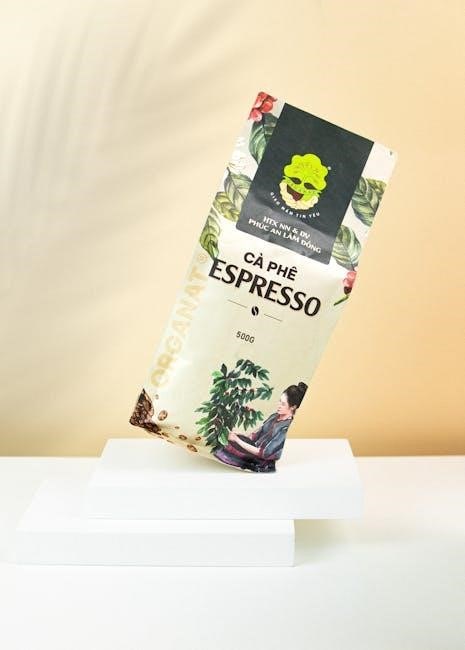
History of Vietnamese Coffee
Coffee was introduced to Vietnam by French colonialists in the 1800s‚ sparking a cultural shift․ Vietnamese adapted it with sweetened condensed milk and the phin filter‚ creating a unique tradition․
Coffee was first introduced to Vietnam in the mid-19th century by French colonialists‚ who sought to establish plantations in the region’s fertile highlands․ The French brought with them coffee plants‚ primarily Arabica and Robusta‚ which thrived in Vietnam’s climate․ Initially‚ coffee production was small-scale‚ but it quickly expanded‚ laying the foundation for Vietnam to become one of the world’s leading coffee producers․ This marked the beginning of a cultural and economic transformation that deeply influenced Vietnamese life․
Evolution of Vietnamese Coffee Traditions
Vietnamese coffee traditions have evolved significantly since the French introduced coffee in the 19th century․ Initially adopted by the elite‚ coffee soon became a staple in everyday life․ The phin filter emerged as a iconic brewing method‚ allowing for a unique‚ slow-drip process; Over time‚ locals adapted French techniques to create distinctive styles‚ such as cà phê sữa đá (iced coffee) and cà phê trứng (egg coffee)․ These innovations‚ combined with a rich cultural embrace‚ have shaped Vietnam’s coffee identity‚ blending tradition with modern creativity․
Key Components of Vietnamese Coffee
The core elements of Vietnamese coffee include the phin filter‚ medium-grind coffee beans‚ sweetened condensed milk‚ and ice․ These components create its distinctive flavor and texture․
- Phin Filter: A small metal drip filter essential for brewing․
- Coffee Beans: Typically robusta beans for bold‚ rich flavor․
- Sweetened Condensed Milk: Adds sweetness and creaminess․
- Ice: Enhances the refreshing quality of iced versions․
The Phin Filter
The phin filter is a small‚ iconic metal device central to Vietnamese coffee brewing․ Its simplicity and design allow coffee grounds to steep in hot water‚ producing a strong‚ full-bodied coffee․ The phin consists of a chamber‚ a filter‚ and a lid‚ enabling a slow drip process that enhances flavor extraction․ It’s easy to use and clean‚ making it a beloved tool for both traditional and modern coffee enthusiasts worldwide․
Vietnamese Coffee Beans
Vietnamese coffee typically uses Robusta beans‚ known for their bold‚ bitter flavor and high caffeine content․ Medium to coarse grinds are ideal for the phin filter‚ ensuring proper extraction․ While some blends include Arabica for a smoother taste‚ Robusta remains the traditional choice․ The beans are often roasted dark to enhance their robust character‚ creating a rich‚ full-bodied coffee experience․ Regional preferences may vary‚ but the bold‚ intense flavor of Vietnamese beans is a cornerstone of its coffee culture․
Sweetened Condensed Milk
Sweetened condensed milk is a cornerstone of Vietnamese coffee‚ adding a creamy‚ sweet texture that balances the boldness of the coffee․ It’s poured directly into the cup before brewing‚ creating a layered effect․ Some prefer mixing it with half-and-half to reduce sweetness‚ while others enjoy it pure․ This ingredient is essential for both hot and iced versions‚ enhancing the flavor profile and making Vietnamese coffee uniquely indulgent․ Its richness complements the coffee’s bitterness‚ creating a harmonious taste experience․
Ice and Its Role in Vietnamese Coffee
Ice plays a vital role in Vietnamese coffee‚ particularly in the popular iced version‚ Cà Phê Sữa Đá․ It cools the coffee‚ balancing its boldness and sweetness․ The process involves brewing hot coffee directly over ice‚ creating a refreshing contrast․ Ice dilutes the coffee slightly‚ enhancing its smoothness and making it perfect for warm weather․ This method highlights the interplay between the rich coffee‚ creamy condensed milk‚ and the chilling effect of ice‚ offering a revitalizing and flavorful experience․

Brewing Methods
Vietnamese coffee offers a variety of brewing techniques‚ from traditional hot and iced methods to creative variations like egg coffee‚ ensuring a rich‚ bold flavor in every cup․
Traditional Hot Vietnamese Coffee (Cà Phê Sữa Nóng)
Traditional hot Vietnamese coffee‚ or cà phê sữa nóng‚ is a beloved method that combines rich‚ bold coffee with sweetened condensed milk․ The process begins by placing coarse coffee grounds in a phin filter‚ which is then steeped in hot water‚ allowing the coffee to drip slowly into a cup․ Sweetened condensed milk is added to the cup beforehand‚ creating a creamy‚ velvety texture․ This iconic brew is a staple in Vietnamese culture‚ offering a perfect balance of bold flavors and sweetness that captivates coffee lovers worldwide․
Vietnamese Iced Coffee (Cà Phê Sữa Đá)
Vietnamese iced coffee‚ or cà phê sữa đá‚ is a refreshing twist on the traditional brew․ Strong coffee is brewed using a phin filter‚ then poured over ice and mixed with sweetened condensed milk․ The result is a creamy‚ sweet‚ and invigorating drink perfect for hot days․ The combination of bold coffee flavors and the richness of condensed milk creates a delightful balance‚ making it a popular choice for those seeking a cool‚ indulgent coffee experience․
Egg Coffee (Cà Phê Trứng)
Egg coffee‚ or cà phê trứng‚ is a unique Vietnamese coffee variation that combines rich coffee with a creamy egg-based topping․ Made by whisking egg yolks with sweetened condensed milk until frothy‚ it creates a velvety texture․ This decadent drink is often served hot‚ with the egg mixture spooned over strong black coffee․ Its creamy‚ sweet flavor has made it a beloved treat in Vietnam‚ particularly in Hanoi‚ where it originated․ A must-try for adventurous coffee lovers seeking a luxurious twist on traditional brews․
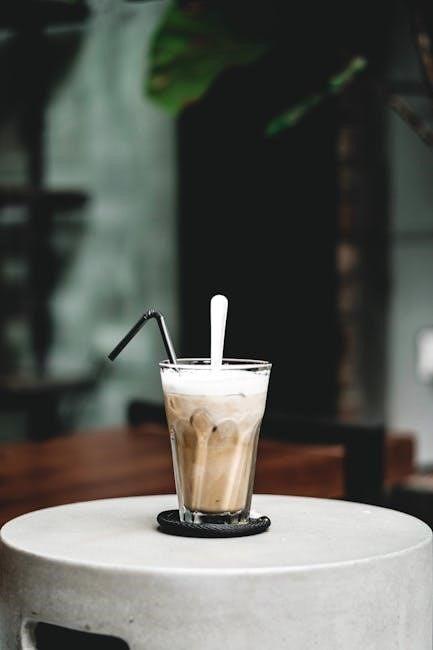
Step-by-Step Guide to Making Vietnamese Coffee
Start by adding sweetened condensed milk to a glass․ Place the phin filter over it‚ add coffee grounds‚ and pour hot water․ Allow the coffee to drip‚ then stir well and enjoy the rich‚ creamy blend․ This traditional method ensures a perfect balance of flavors‚ creating a delightful coffee experience․
Ingredients and Equipment Needed
- Phin filter: A small metal filter essential for traditional brewing․
- Coffee beans: Medium-coarse grind‚ preferably robusta or a blend․
- Sweetened condensed milk: Adds sweetness and creaminess․
- Hot water: Used for brewing‚ ideally at 195°F to 205°F․
- Glass or mug: For serving‚ often with ice for iced versions․
- Optional: Half-and-half or vanilla for flavor variation․
These simple ingredients and tools create the authentic Vietnamese coffee experience․
Brewing Process Using a Phin Filter
Start by placing the phin filter over your glass․ Add 2-3 tablespoons of medium-ground coffee and press firmly․ Pour a small amount of hot water to bloom the grounds‚ then fill the filter․ Allow the coffee to drip slowly․ Once done‚ stir in sweetened condensed milk․ For iced coffee‚ pour over ice and mix well․ This traditional method ensures a rich‚ bold flavor with a creamy texture‚ perfect for any time of day․
Adjusting Sweetness and Milk Preferences
Adjust the sweetness by varying the amount of sweetened condensed milk․ For a sweeter taste‚ add more milk‚ or reduce it for a bolder flavor․ Some prefer mixing milk with half-and-half to balance sweetness․ Experiment with ratios to find your ideal blend․ The key is to tailor the coffee to your taste‚ ensuring a harmonious balance between rich coffee and creamy sweetness for a personalized experience․

Tips for the Perfect Cup
Ensure a medium grind for optimal extraction․ Balance coffee and milk ratios to your taste․ Use fresh‚ high-quality beans for the best flavor and aroma consistency․
Coffee-to-Milk Ratio
The ideal coffee-to-milk ratio in Vietnamese coffee is 2-3 tablespoons of coffee to 1-2 tablespoons of sweetened condensed milk․ This balance ensures a rich‚ bold flavor without overpowering sweetness․ Adjusting the ratio allows customization to suit personal taste preferences‚ whether you prefer a stronger coffee flavor or a sweeter‚ creamier texture․ Maintaining this proportion is key to achieving the authentic Vietnamese coffee experience‚ where the bitterness of the coffee harmonizes perfectly with the sweetness of the milk․
Importance of Coffee Grind Size
The grind size of the coffee is crucial for achieving the perfect Vietnamese coffee․ A medium to coarse grind is ideal‚ as it allows the right flow of water through the phin filter․ Too fine a grind can clog the filter‚ leading to a slower brew and a bitter taste‚ while too coarse a grind may result in under-extraction․ The right grind ensures optimal extraction‚ balancing the bold‚ rich flavors that define Vietnamese coffee․ Adjusting the grind size can fine-tune the brewing process for a flawless cup․
Common Mistakes to Avoid
Common mistakes when brewing Vietnamese coffee include using the wrong grind size‚ which can lead to uneven extraction‚ and not blooming the coffee grounds properly․ Overfilling the phin filter can cause overflow‚ while underfilling results in a weak brew․ Stirring too vigorously after adding condensed milk disrupts the layered effect․ Using water that’s too hot or too cold affects flavor extraction․ Lastly‚ rushing the brewing process can lead to a bitter or underdeveloped taste․ Avoiding these errors ensures a balanced and authentic Vietnamese coffee experience․
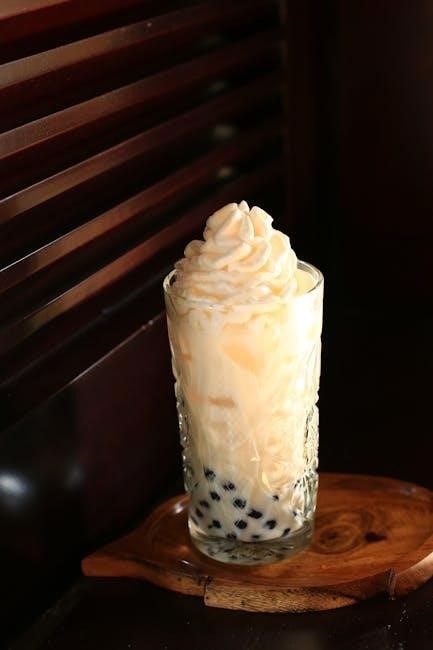
Regional Variations
Vietnamese coffee varies by region‚ with Northern styles favoring stronger‚ darker roasts and Southern styles often sweeter‚ incorporating coconut milk or other local twists for unique flavors․
Northern vs․ Southern Vietnamese Coffee Styles
Northern Vietnamese coffee tends to be stronger and darker‚ often served black or with a touch of sweetened condensed milk‚ reflecting a more traditional approach․ In contrast‚ Southern styles are sweeter‚ frequently using generous amounts of condensed milk and sometimes coconut milk for a creamier texture․ These regional differences highlight the diversity of Vietnamese coffee culture‚ catering to varying preferences while maintaining the core elements that make the beverage iconic and beloved worldwide․
Unique Coffee Drinks Across Vietnam
Vietnam boasts a variety of unique coffee drinks that showcase its rich culinary creativity․ Egg coffee (cà phê trứng) stands out with its creamy egg yolk topping‚ while coconut coffee blends tropical flavors․ Iced coffee (cà phê sữa đá) offers a refreshing twist‚ and yogurt coffee provides a tangy alternative․ Each region introduces its own twist‚ such as Hanoi’s dense egg foam or Saigon’s sweet iced versions․ These innovative creations highlight Vietnam’s coffee culture as both diverse and delightful‚ catering to every palate and preference․
Pairing Vietnamese Coffee with Food
Vietnamese coffee pairs perfectly with traditional snacks like bánh ngọt (sweet pastries) and bánh mì (Vietnamese bread)․ Modern pairings include croissants‚ chocolates‚ or even coconut desserts for a sweet contrast․
Traditional Vietnamese Snacks
Traditional Vietnamese snacks like bánh ngọt (sweet pastries) and bánh mì (Vietnamese bread) complement the rich flavors of Vietnamese coffee․ These snacks‚ often served in local cafés‚ provide a delightful contrast to the bold‚ sweet coffee․ Bánh ngọt‚ with its flaky texture and sweet fillings‚ pairs perfectly with the creamy condensed milk in Vietnamese coffee․ Similarly‚ bánh mì adds a satisfying crunch‚ enhancing the overall coffee experience․ These pairings reflect the cultural tradition of enjoying coffee with light‚ flavorful bites․
Modern Food Pairing Ideas
Modern food pairing ideas for Vietnamese coffee include desserts like avocado mousse or matcha tiramisu‚ which contrast its bold flavors․ Coconut macaroons or dark chocolate truffles also complement the coffee’s richness․ For a savory twist‚ pair it with grilled banana bread or cinnamon churros․ These contemporary combinations enhance the coffee’s unique profile while offering a fresh‚ modern twist to traditional pairings․ Experimenting with textures and flavors creates a delightful and innovative coffee experience․

Health Benefits and Caffeine Content
Vietnamese coffee offers antioxidants and a caffeine boost‚ with robusta beans providing higher caffeine content than arabica․ It may improve alertness and energy‚ supporting mental clarity․
Health Benefits of Vietnamese Coffee
Vietnamese coffee offers several health benefits‚ starting with its high antioxidant content from the coffee beans․ These antioxidants help protect against free radicals‚ potentially reducing inflammation and improving overall health․ The caffeine in Vietnamese coffee can boost alertness‚ enhance cognitive function‚ and increase energy levels‚ making it a great morning pick-me-up․ Additionally‚ the sweetened condensed milk adds calcium and vitamins‚ contributing to bone health․ Moderate consumption may also support heart health and metabolism‚ while the ritual of brewing fosters mindfulness and social connection‚ enriching mental well-being․
Caffeine Levels in Vietnamese Coffee
Vietnamese coffee typically contains higher caffeine levels due to the use of robusta beans‚ which naturally have more caffeine than arabica․ A traditional cup can range from 200-400mg of caffeine‚ depending on serving size and brew strength; The concentrated brewing method with a phin filter contributes to its bold‚ energizing effect; For those sensitive to caffeine‚ adjusting the coffee-to-milk ratio or using less coffee grounds can help moderate intake while still enjoying the rich‚ distinctive flavor of Vietnamese coffee․
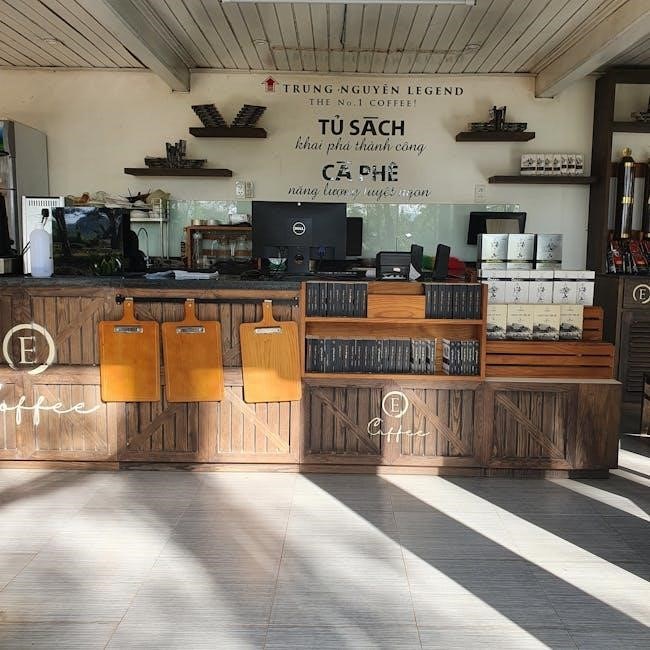
Modern Twists and Innovations
Modern twists on Vietnamese coffee include using espresso for a quicker brew and creative variations like flavor infusions or plant-based milks‚ blending tradition with contemporary tastes․
Using Espresso for a Quick Brew
For a faster alternative‚ espresso can replace traditionally brewed coffee in Vietnamese recipes․ This modern twist retains the rich‚ bold flavor while saving time․ Simply pull a shot of espresso‚ mix with sweetened condensed milk‚ and pour over ice for a quick Vietnamese iced coffee․ The creamy texture and balanced sweetness remain intact‚ offering a convenient yet authentic experience for those seeking efficiency without compromising on taste․
Creative Variations of Vietnamese Coffee
Vietnamese coffee offers a canvas for creativity beyond tradition․ Egg coffee substitutes milk with a creamy egg foam‚ while coconut coffee adds tropical flair․ Modern twists include plant-based milks‚ flavored syrups‚ or spices like cinnamon․ Some blend espresso with condensed milk for a quicker version․ These variations preserve the drink’s essence while catering to diverse tastes‚ making Vietnamese coffee adaptable to global palates and preferences․
DIY Vietnamese Coffee Recipes
Explore homemade recipes for Vietnamese coffee‚ including sweetened condensed milk and phin filter alternatives․ These DIY methods offer cost-effective and fresh ways to enjoy authentic flavors at home․
Homemade Sweetened Condensed Milk Recipe
Make sweetened condensed milk at home with just 3 ingredients: 2 cups milk‚ 1 cup sugar‚ and 1 tsp vanilla extract (optional)․ Heat the milk in a saucepan over medium heat until simmering․ Gradually add sugar‚ stirring until dissolved․ Reduce heat to low and simmer for 10-15 minutes‚ skimming foam‚ until thickened․ Remove from heat‚ stir in vanilla‚ and let cool․ Store in an airtight container for up to 1 week․ Perfect for Vietnamese coffee recipes!
DIY Phin Filter Alternative
If you don’t have a phin filter‚ you can use a fine-mesh sieve or cheesecloth as an alternative․ Simply place the ground coffee in the sieve or wrap it in cheesecloth‚ securing with a rubber band․ Suspend it over your cup‚ pour hot water slowly‚ and let it drip․ This method mimics the phin’s functionality‚ allowing the coffee to steep and drain naturally․ While not traditional‚ it provides a similar rich‚ bold flavor for a delicious Vietnamese coffee experience at home․

Where to Buy Vietnamese Coffee Products
Vietnamese coffee products are available at Asian grocery stores‚ online retailers like Amazon‚ and specialty coffee shops․ Popular brands include Trung Nguyen and Vinacafe․
Recommended Coffee Brands
For an authentic Vietnamese coffee experience‚ consider brands like Trung Nguyen‚ Vinacafe‚ and Café Du Monde․ These brands offer high-quality beans and ground coffee specifically designed for Vietnamese brewing methods․ Trung Nguyen is a popular choice‚ known for its rich‚ bold flavors․ Vinacafe provides a smooth and balanced taste‚ while Café Du Monde is famous for its dark roast and chicory blends․ These brands are widely available in Asian grocery stores and online retailers‚ ensuring accessibility for coffee enthusiasts worldwide․
Online Retailers and Specialty Stores
Vietnamese coffee products are widely available online‚ making it easy to source authentic ingredients․ Retailers like Amazon‚ Etsy‚ and specialty stores such as Nguyen Coffee Supply and Little Saigon offer a variety of Vietnamese coffee beans‚ phin filters‚ and sweetened condensed milk․ These platforms cater to both traditionalists and modern coffee enthusiasts‚ ensuring you can enjoy the authentic taste of Vietnamese coffee from the comfort of your home․ Online stores provide convenient access to high-quality products for a perfect brew․
Vietnamese coffee offers a rich‚ cultural brewing experience with its unique flavors and traditional methods‚ making every sip a delightful journey through Vietnam’s coffee heritage․
Final Thoughts on Vietnamese Coffee
Vietnamese coffee is a harmonious blend of tradition and flavor‚ offering a unique experience․ Its rich‚ bold taste‚ combined with sweetened condensed milk‚ creates a creamy texture that captivates coffee lovers․ The simplicity of the phin filter brewing method makes it accessible to everyone․ Whether enjoyed hot or iced‚ Vietnamese coffee is a delightful way to explore the country’s vibrant culture and coffee heritage‚ ensuring a memorable and satisfying experience for all who try it․
Encouragement to Try Vietnamese Coffee
Vietnamese coffee offers a unique and flavorful experience that captivates coffee lovers worldwide․ With its rich‚ bold taste and creamy texture from sweetened condensed milk‚ it’s a must-try for anyone seeking a new coffee adventure․ Whether you prefer it hot or iced‚ Vietnamese coffee provides a refreshing and indulgent treat․ Its cultural significance and simple brewing method make it accessible to everyone․ Give it a try and discover why it’s a beloved staple in Vietnam and beyond!
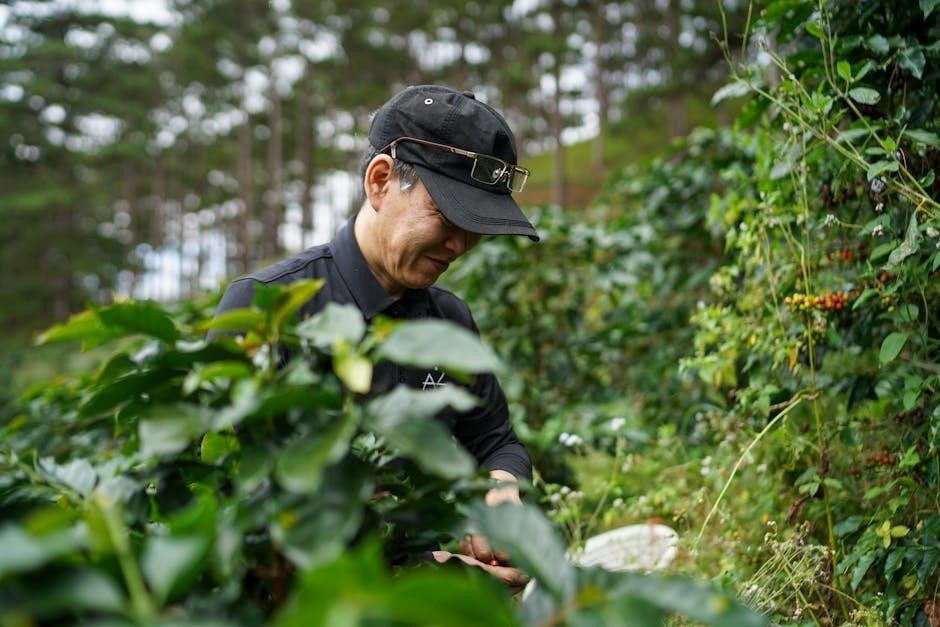
Frequently Asked Questions
Common questions about Vietnamese coffee include the best beans to use‚ the role of sweetened condensed milk‚ and troubleshooting brewing issues․ Explore these FAQs for insights․
Common Questions About Vietnamese Coffee
Common questions about Vietnamese coffee often revolve around the best coffee beans to use‚ the ideal ratio of coffee to condensed milk‚ and troubleshooting brewing issues․ Many wonder if espresso can substitute for traditional beans or how to adjust sweetness levels․ Others inquire about the differences between Northern and Southern coffee styles․ Additionally‚ questions about the phin filter’s maintenance and the best brands for authentic flavor frequently arise․ These inquiries highlight the curiosity and enthusiasm for mastering this unique coffee tradition․
Troubleshooting Brewing Issues
Common brewing issues with Vietnamese coffee often stem from uneven extraction or weak flavor․ Ensure the coffee grind is medium-coarse and evenly distributed in the phin․ If coffee is too weak‚ check the grind size or tamping pressure․ Over-extraction can occur if water is too hot or poured too slowly․ Adjusting the coffee-to-milk ratio can also resolve issues like overly sweet or bitter taste․ Proper cleaning of the phin filter is essential to prevent residue buildup‚ which can affect flavor quality․
